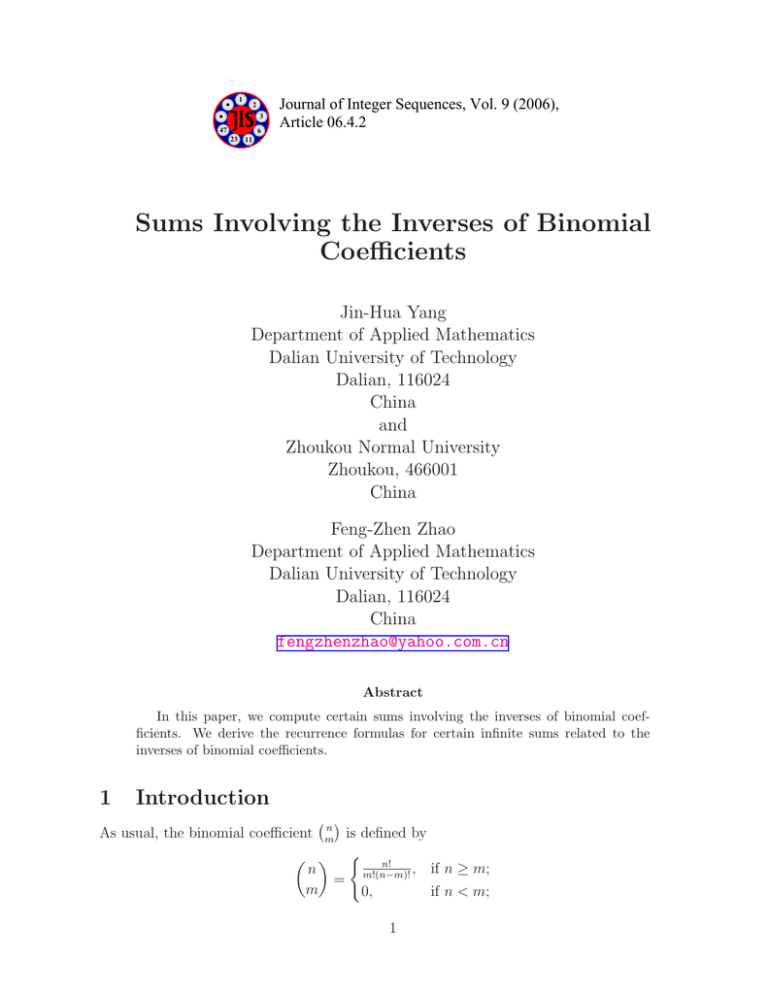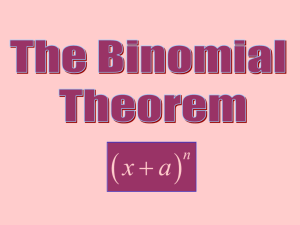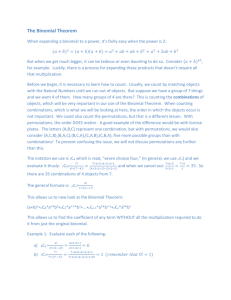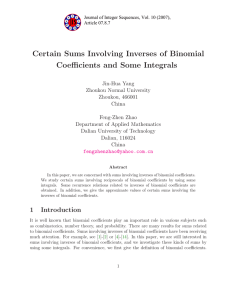Sums Involving the Inverses of Binomial Coefficients
advertisement

1 2 3 47 6 Journal of Integer Sequences, Vol. 9 (2006), Article 06.4.2 23 11 Sums Involving the Inverses of Binomial Coefficients Jin-Hua Yang Department of Applied Mathematics Dalian University of Technology Dalian, 116024 China and Zhoukou Normal University Zhoukou, 466001 China Feng-Zhen Zhao Department of Applied Mathematics Dalian University of Technology Dalian, 116024 China fengzhenzhao@yahoo.com.cn Abstract In this paper, we compute certain sums involving the inverses of binomial coefficients. We derive the recurrence formulas for certain infinite sums related to the inverses of binomial coefficients. 1 Introduction As usual, the binomial coefficient ¡n¢ m µ ¶ n = m is defined by ( n! , if n ≥ m; m!(n−m)! 0, if n < m; 1 where n and m are nonnegative integers. There are many identities involving binomial coefficients. However, computations related to the inverses of binomial coefficients are difficult. For some results involving the inverses of binomial coefficients, see [5, 4, 1, 6, 8, 9, 7, 10]. In order to compute sums involving the inverses of binomial coefficients, using integrals is an effective approach. This idea is based on Euler’s well-known Beta function defined by (see [8]) Z 1 B(n, m) = tn−1 (1 − t)m−1 dt 0 (n − 1)!(m − 1)! Γ(n)Γ(m) = , the inverse for all positive integers n and m. Since B(n, m) = Γ(n + m) (n + m − 1)! ¡ n ¢−1 satisfies the identity binomial coefficient m µ ¶−1 Z 1 n = (n + 1) tm (1 − t)n−m dt. m 0 (1) with this method, a series of identities related to the inverses of binomial coefficients is obtained (see [8, 9, 7, 10]). In this paper, we also use Eq. (1) to evaluate the sums ∞ X n=1 ∞ X n=1 ∞ X εn ¡ ¢, n(n + k) 2n n n=1 εn ¡ ¢, n2 (n + k) 2n n ∞ X εn εn ¡2n+k¢, and ¡2n+2k¢, n(n + k) n n(n + k) n+k n=1 where |ε| = 1, and k is an arbitrary positive integer with k > 1. For convenience, we put S1 (k) = T1 (k) = Q1 (k) = ∞ X n=1 ∞ X n=1 ∞ X n=1 R1 (k) = ∞ X n=1 1 ¡ ¢, n(n + k) 2n n S2 (k) = ∞ X (−1)n ¡ ¢, n(n + k) 2n n n=1 ∞ X 1 ¡ ¢, 2 n (n + k) 2n n T2 (k) = 1 ¡ ¢, n(n + k) 2n+k n n=1 ∞ X (−1)n ¡2n+k¢ , n(n + k) n n=1 ∞ n X (−1) ¢. ¡ R2 (k) = n(n + k) 2n+2k n+k n=1 Q2 (k) = 1 ¢, ¡ n(n + k) 2n+2k n+k (−1)n ¡ ¢, n2 (n + k) 2n n In the next section, we evaluate the sums above. In the third section, we define Wk = ∞ r X 1 1X ¡2n¢ and Xr = Wk ; our aim is to compute lim Xr . r→+∞ r k=1 nk n n=1 2 2 Some Results For Si(k) And Ti(k) (1 ≤ i ≤ 2) Theorem 2.1. Let k be a positive integer with k ≥ 2. Then 1 − 2k S1 (k) = k 1 Z ln[1 − t(1 − t)] + tk (1 0 1 i=1 − t)k ti (1 − t)i /i ln[1 + t(1 − t)] + (1 − 2k) S2 (k) = (−1)k k √ 0 µ ¶ 2 √ 5+1 5 ln − −1 , k 2 S1 (k) π2 − , T1 (k) = 18k k µ √ ¶2 5−1 2 S2 (k) . T2 (k) = − ln − k 2 k Z k X k X tk (1 i=1 √ ¶ µ 3π 1 dt + 2− , k 3 (−1)i ti (1 − t)i /i − t)k (2) dt (3) (4) (5) Proof. It follows from Eq. (1) that ¶X ∞ R1 n t (1 − t)n dt 1 0 tn (1 − t)n dt + 2 − k n=1 n+k 0 R ¶ ∞ µ Z 1 ∞ 1 X 0 tn−k (1 − t)n−k dt 1X1 1 n n , t (1 − t) dt + 2 − = k n=1 n 0 k n=k+1 n ∞ 1X1 S1 (k) = k n=1 n ∞ 1 X (−1)n S2 (k) = k n=1 Z R1 0 1 µ R1 ¶ ∞ µ tn (1 − t)n dt 1 X (−1)n−k 0 tn−k (1 − t)n−k dt + 2− . n k n=k+1 n It is well known that ∞ X un n n=1 = − ln(1 − u), for u ∈ [−1, 1). (6) On the other hand, √ 1 3π ln(1 − t + t )dt = −2 + , 3 0 √ ¶ µ Z 1 √ 5+1 2 −1 . ln(1 + t − t )dt = 2 5 ln 2 0 Z 2 From Eqs. (6-8) we get Eqs. (2) and (3). 3 (7) (8) Now we give the proofs of Eqs. (4-5). One can verify that ∞ ∞ ∞ 1 1X 1 1X 1 1X 1 ¡2n¢ − ¡2n¢ − S1 (k), ¡2n¢ = T1 (k) = 2 2 k n=1 n n k n=1 n(n + k) n k n=1 n n k ∞ 1 1 X (−1)n ¡2n¢ − S2 (k). T2 (k) = 2 k n=1 n n k It follows from [2, 10] that ∞ X n=1 π2 1 ¡2n¢ = , 18 n2 n Hence Eqs. (4-5) are valid. µ √ ¶2 ∞ X 5−1 (−1)n ¡ ¢ = −2 ln . 2 n2 2n n n=1 Next, we extend Si (k) and Ti (k)(i = 1, 2) to the following forms: S1 (k, m) = ∞ X n=1 T1 (k, m) = ∞ X n=1 1 ¡ ¢, n(n + k) 2mn mn S2 (k, m) = ∞ X n=1 (−1)n ¡ ¢, n(n + k) 2mn mn ∞ X 1 (−1)n ¡2mn¢ , and T2 (k, m) = ¡ ¢. 2 (n + k) 2mn n2 (n + k) mn n mn n=1 we give the corresponding results as a corollary: Corollary 2.1. Let k and m be positive integers. Then m S1 (k, m) = µ ¶Z 1 m ln[1 − t (1 − t) ] + k X tmi (1 − t)mi /i 1 i=1 − 2m mk k t (1 − t)mk 0 Z 1 1 − ln[1 − tm (1 − t)m ]dt, k 0 m µ ¶Z 1 m ln[1 + t (1 − t) ] + (9) k X (−1)i tmi (1 − t)mi /i 1 i=1 − 2m S2 (k, m) = (−1)k mk (1 − t)mk k t 0 Z 1 1 − ln[1 + tm (1 − t)m ]dt, k 0 Z m 1 ln[1 − tm (1 − t)m ]dt 1 − S1 (k, m), T1 (k, m) = − 2k 0 t(1 − t) k Z 1 m m ln[1 + t (1 − t) ]dt 1 m − S2 (k, m). T2 (k, m) = − 2k 0 t(1 − t) k 4 dt dt (10) (11) (12) Proof. We only give the proofs of Eqs. (11-12), and leave the proofs of Eqs. (9-10) to the reader. We can immediately obtain that ∞ ∞ ∞ 1 1 1 1X 1 1X 1X ¡2mn¢ − ¡2mn¢ − S1 (k, m), ¡2mn¢ = T1 (k, m) = 2 2 k n=1 n mn k n=1 n(n + k) mn k n=1 n mn k ∞ 1 1 X (−1)n ¡2mn¢ − S2 (k, m). T2 (k, m) = 2 k n=1 n mn k Owing to the conclusions (see [10]): ∞ X n=1 m 1 ¡2mn¢ = − 2 2 n mn Z 1 0 ln[1 − tm (1 − t)m ]dt t(1 − t) Z ∞ X m 1 ln[1 + tm (1 − t)m ]dt (−1)n ¡2mn¢ = − , 2 0 t(1 − t) n2 mn n=1 we can show that Eqs. (11-12) hold. It is evident that Eqs. (9-12) are the generalizations of Eqs. (2-5), respectively. Now we give the recurrence relation for Si (k) and Ti (k). Theorem 2.2. Let k be a positive integer with k ≥ 2. Then √ 3π 2(2k + 1) 1 S1 (k + 1) = S1 (k) + − , 2 k+1 (k + 1) 3(k + 1) √ √ 5+1 1 2 5 2(2k + 1) S2 (k) + − ln , S2 (k + 1) = − 2 k+1 (k + 1) k+1 2 √ 3π 1 (3k + 1)π 2 2k(2k + 1) + T1 (k) − + , T1 (k + 1) = − 2 2 3 18(k + 1) (k + 1) (k + 1) 3(k + 1)2 ¶2 µ √ 5−1 2(5k + 3) 2k(2k + 1) 1 T2 (k + 1) = − ln − T2 (k) − 2 2 (k + 1) 2 (k + 1) (k + 1)3 √ √ 5+1 2 5 + ln . 2 (k + 1) 2 Proof. For 0 < a ≤ 1, we consider the integrals: Ik (a) = µ Jk (a) = (−1)k k X ai ti (1 − t)i /i ¶ Z 1 ln[1 − at(1 − t)] + 1 i=1 −2 dt k (1 − t)k k t 0 µ k X (−1)i ai ti (1 − t)i /i ¶ Z 1 ln[1 + at(1 − t)] + 1 i=1 −2 dt, k k t (1 − t)k 0 5 (13) (14) (15) (16) where Ik (0) = 0 and Jk (0) = 0. It is clear that √ √ ¶ µ µ ¶ 3π 5+1 2 √ 1 5 ln 2− and S2 (k) = Jk (1) − −1 . S1 (k) = Ik (1) + k 3 k 2 When 0 < a ≤ 1, we have ¶ µ ¶ Z 1 dt 1 k−1 . 1− = −2 a 2 k 0 1 − at + at r r ¶ µ ¶µ a a 1 k−1 k−2 , = −2 a − 4a arctan k 4−a 4−a ¶Z 1 k µ a t(1 − t)dt 1 ′ −2 Jk (a) = k 0 1 + at(1 − t) r a+4 µ ¶µ √ + 1¶ k−2 a 1 2a a k−1 ln r . = −2 a − √ k a+4 a+4 −1 a Ik′ (a) µ Hence (2k − 1)ak 4(2k − 1) Ik (a) = − + k2 k Jk (a) = Let u = r a and 4−a Ik (a) Jk (a) r a a arctan da. a 4−a 4−a r a+4 r Z +1 k a (2k − 1)a 2(2k − 1) a k−2 da. − + ln r a k2 k a+4 a+4 −1 a r a+4 v= . Then we get a Z 2k−2 u arctan u (2k − 1)ak (2k − 1)22k+1 + du, = − 2 k k (1 + u2 )k Z (2k − 1)ak (2k − 1)4k 1 v+1 = − − ln dv. 2 2 k k k (v − 1) v−1 Z k−2 r It is well known that Z 2k Z 2k−2 u arctan u 2k − 1 u2k−1 arctan u u arctan u du = du − (1 + u2 )k+1 2k (1 + u2 )k 2k(1 + u2 )k Z u2k−1 1 du, + 2k (1 + u2 )k+1 Z Z 1 1 v+1 2k − 1 v+1 1 ln dv = − ln dv + 2 2 2 k+1 2 k (v − 1) v−1 2k (v − 1) v−1 2k (v − 1)k v+1 v ln . − 2 k 2k(v − 1) v−1 6 (17) (18) In the meantime, we note that Z Z 2 u2k−1 du = k+1 ak−1 da and Ik (0) = Jk (0) = 0. (1 + u2 )k+1 4 Therefore Ik (a) and Jk (a) satisfy that √ r ak+1 4ak 4 4 − aak−1/2 k+1 a Ik+1 (a) = 2Ik (a) − + − arctan , 2k + 1 k+1 k k 4−a √ √ √ a+4+ a k+1 ak+1 4ak 2ak−1/2 a + 4 Jk+1 (a) = −2Jk (a) − − + ln √ √ . 2k + 1 k+1 k k a+4− a (19) (20) From Eqs. (19-20) we can derive Eqs. (13-14). According to Eqs. (4-5) we can obtain Eqs. (15-16). We note that the recurrences given in Eqs. (13-14) are similar to [3, Eq. (28)]. Theorem 2.3. Let k be a positive integer with k ≥ 2. Then k X ti (1 − t)i /i ¶ Z 1 ln[1 − t(1 − t)] + 1 i=1 −1 dt Q1 (k) = k k t 0 µ ¶Z 1 1 − 1+ (1 − t)k ln[1 − t(1 − t)]dt, k 0 k X (−1)i ti (1 − t)i /i µ ¶ Z 1 ln[1 + t(1 − t)] + 1 i=1 Q2 (k) = (−1)k −1 dt k k t 0 µ ¶Z 1 1 − 1+ (1 − t)k ln[1 + t(1 − t)]dt, k 0 ¾ Z 1½ k X ti (1 − t)i 1 dt ln[1 − t(1 − t)] + R1 (k) = k 0 i i=1 µ ¶Z 1 1 − 2+ tk (1 − t)k ln[1 − t(1 − t)]dt, k 0 µ ¾ Z ½ k X (−1)k 1 (−1)i ti (1 − t)i R2 (k) = dt ln[1 + t(1 − t)] + k i 0 i=1 ¶Z 1 µ 1 tk (1 − t)k ln[1 + t(1 − t)]dt. − 2+ k 0 7 (21) (22) (23) (24) Proof. We only give the proof of Eq. (21). The proofs of Eqs. (22-24) follow the same pattern and are omitted here. It follows from Eq. (1) and Eq. (6) that Z ∞ X 2n + k + 1 1 tn (1 − t)n+k dt n(n + k) 0 n=1 µ ¶ X ¶ ∞ Z µ ∞ Z 1 n−k 1 t (1 − t)n 1 X 1 tn (1 − t)n+k = 1− dt + 1 + dt. k n=k+1 0 n k n=1 0 n Q1 (k) = k X ti (1 − t)i /i ¶Z 1 1 i=1 = −1 dt k k t 0 ¶Z 1 µ 1 (1 − t)k ln[1 − t(1 − t)]dt. − 1+ k 0 µ ln[1 − t(1 − t)] + Hence Eq. (21) holds. By computing integrals of Eqs. (17-18) and Eqs. (21-24), we can establish a series of identities involving inverses of binomial coefficients. In the final part of this section, we evaluate special cases of Si (k), Ti (k), and Ri (k)(1 ≤ i ≤ 2) according to the particular choice of k. For example, when k = 2 in Eqs. (17-18), we have Z 2 3a2 u arctan udu I2 (a) = − + 48 4 (1 + u2 )2 12 3a2 24u arctan u − + 12(arctan u)2 − + c2 = − 2 4 1+u 1 + u2 r r µ ¶2 p 3a2 a a − 6 a(4 − a) arctan + 12 arctan = − − 12 + 3a + c2 . 4 4−a 4−a Z 3a2 1 v+1 J2 (a) = − − 24 ln dv 4 (v 2 − 1)2 v − 1 ¶ µ 3a2 v+1 12v v+1 12 2 = − + c′2 + 2 ln − 2 − 3 ln 4 v −1 v−1 v −1 v−1 √ µ√ √ ¶ √ 2 p a+4+ a 3a a+4+ a 2 + 3 a(a + 4) ln √ = − + c′2 . √ − 3a − 3 ln √ √ 4 a+4− a a+4− a Since I2 (0) = 0 and J2 (0) = 0, then c2 = 12, c′2 = 0, √ 15 9 √ π2 I2 (1) = − 3π + , J2 (1) = − + 6 5 ln 4 3 4 8 √ 5+1 − 12 ln2 2 µ√ ¶ 5+1 . 2 Hence, we get √ √ 7 3π 13 5π 2 13 7 3π π 2 − + , T1 (2) = − − , S1 (2) = 4 6 3 12 8 36 √ ¶ µ√ √ 5+1 5+1 11 2 S2 (2) = − + 5 5 ln , − 12 ln 4 2 2 √ √ µ√ ¶ 5+1 5+1 11 5 5 2 − ln + 5 ln . T2 (2) = 8 2 2 2 By means of Si (2), Ti (2), and Eqs. (13-16), we can compute other values of Si (k) and Ti (k)(1 ≤ i ≤ 2, k > 2). If k = 2 in Eqs. (23-24), we can obtain ¸ Z · t2 (1 − t)2 1 1 2 ln(1 − t + t ) + t(1 − t) + dt R1 (2) = 2 0 2 Z 5 1 2 − t (1 − t)2 ln(1 − t + t2 )dt 2 0 √ 3π 17 − , = 36Z ·12 ¸ 1 1 t2 (1 − t)2 2 R2 (2) = dt ln(1 + t − t ) − t(1 − t) + 2 0 2 Z 5 1 2 t (1 − t)2 ln(1 + t − t2 )dt − 2 0 √ √ 5−1 1 5 5 = + ln . 36 6 2 3 The Value of lim Xr r→+∞ √ 3π π2 17π 4 , W2 = , and W4 = (see [2]). However, we do not We know that W1 = 9 18 3240 know how to evaluate Wk in closed form when k ≥ 5. In this section, we are interested in the average Xr of Wk . We compute lim Xr by Eq. (1). r→+∞ 1 Theorem 3.1. Let r be a positive integer with r > 4. Then lim Xr = . r→+∞ 2 Proof. One can verify that 1 1 X 1 − n1r ¡ ¢. Xr = + 2 r n=2 (n − 1) 2n n ∞ 9 Since 1 − 1 nr+1 < 1, the series ∞ X n=2 ∞ X n=2 It follows from Eq. (1) that ∞ X n=2 Then ∞ X n=2 1 n¡r ¢ satisfies that (n − 1) 2n n 1− X 1 − n1r 1 ¡2n¢ ≤ ¡ ¢. (n − 1) n (n − 1) 2n n n=2 ∞ R1 ∞ X (2n + 1) 0 tn (1 − t)n dt 1 ¡ ¢= . n−1 (n − 1) 2n n n=2 R1 ∞ X (2n + 3) 0 tn+1 (1 − t)n+1 dt 1 ¡ ¢ = n (n − 1) 2n n n=1 Z 1 2 Z 1 t (1 − t)2 dt = 2 t(1 − t) ln[1 − t(1 − t)]dt. −3 2 0 [1 − t(1 − t)] 0 1 Hence lim Xr = . r→+∞ 2 4 Acknowledgments The authors are grateful to the referee for a careful reading and for numerous suggestions, all of which have helped improve the presentation of this article. References [1] M. R. Andrew, Sums of the inverses of binomial coefficients, Fibonacci Quart. 19 (1981), 433–437. [2] L. Comtet, Advanced Combinatorics, Reidel, 1974. [3] C. Elsner, On recurrence formulae for sums involving binomial coefficients, Fibonacci Quart. 43 (2005), 31-45. [4] P. Juan, The sum of inverses of binomial coefficients revisited, Fibonacci Quart. 35 (1997), 342–345. [5] P. Nicolae, Problem C:1280, Gaz. Mat. 97 (1992), 230. [6] B. Sury, Sum of the reciprocals of the binomial coefficients, European J. Combin. 14 (1993), 351–353. 10 [7] B. Sury, Tianming Wang, and Feng-Zhen Zhao, Some identities involving reciprocals of binomial coefficients, J. Integer Sequences 7 (2004), Article 04.2.8. [8] T. Tiberiu, Combinatorial sums and series involving inverses of binomial coefficients, Fibonacci Quart. 38 (2000), 79–84. [9] WMC Problems Group, Problem 10494, Amer. Math. Monthly 103 (1996), 74. [10] Feng-Zhen Zhao and Tianming Wang, Some results for sums of the inverses of binomial coefficients, Integers 5 (1) (2005), Paper A22. 2000 Mathematics Subject Classification: Primary 11B65. Keywords: binomial coefficients, integral, recurrence relation. Received June 26 2006; revised version received September 3 2006. Published in Journal of Integer Sequences, September 3 2006. Return to Journal of Integer Sequences home page. 11









